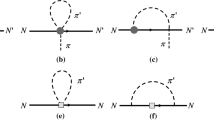Abstract
Time (T) and simultaneous parity-time (PT) symmetry violations in the nuclear system generally cause the gamma ray multipole mixing ratios to acquire imaginary components. These complex phases may then be measured experimentally by virtue of the resulting gamma ray distributions. However, the true significance of such experiments may only be assessed once the imaginary mixing ratios have been related theoretically to the coupling constant of some fundamental, symmetry violating, interaction. We discuss, in a quantitative way, the various aspects of this relationship. To illustrate this further we examine the case of the 1189 keV transition in182W. For this transition we predict the experimentally observable\((\overline {E2} , M2)\) mixing ratio to have a parity (P) violating real part of ≅5×10−5 and a PT violating imaginary part of\( \simeq 200\bar g_{PT(1)} \), where\(\bar g_{PT(1)} \) is the strength of the isovector PT violating pion-nucleon coupling. An upper limit to this coupling of ≲3×10−10 may be obtained from the electric dipole moment of the neutron.
Similar content being viewed by others
References
F. Boehm, Hyp. Int. 43 (1988) 95.
W. Mampe, Fundamental Symmetries in Nuclei and Particles, eds. H. Henrikson and P. Vogel, (World Scientific, Singapore, 1990) p. 157.
G. Barton and E. G. White, Phys. Rev. 184, (1969) 1660.
R. J. Crewther, P. Di Vecchia, G. Veneziano and E. Witten, Phys. Lett 88B, (1979) 123.
P. Herczeg, in Tests of Time Reversal Invariance, eds. N.R. Roberson, C.R. Gould and J.D. Bowman, (World Scientific, Singapore, 1987) p. 24. See also P. Herczeg, Hyp. Int. 43, (1988) 77.
B.T. Murdoch, C.E. Olsen, S.S. Rosenblum and W.A. Steyert, Phys. Lett. 52B, (1974) 325.
K. Alder and R.M. Steffen, in The Electromagnetic Interaction In Nuclear Spectroscopy, ed. W.D. Hamilton, (North-Holland, Amsterdam, 1975) p. 1.
A. Griffiths and P. Vogel, Phys. Rev. C44, (1991) 1215.
A. Griffiths and P. Vogel, Phys. Rev. C43, (1991) 2884.
A. Griffiths and P. Vogel, Phys. Rev. Phys. Rev. C44, (1991) 1195.
E. G. Adelberger, in Proceedings of the International Symposium on Weak and Electromagnetic Interactions in Nuclei, ed. H. V. Klapdor, (Springer-Verlag, 1986) p.592.
Author information
Authors and Affiliations
Rights and permissions
About this article
Cite this article
Griffiths, A., Vogel, P. The expected magnitude of simultaneous parity and time violation in nuclear systems. Hyperfine Interact 75, 173–180 (1992). https://doi.org/10.1007/BF02398974
Issue Date:
DOI: https://doi.org/10.1007/BF02398974




